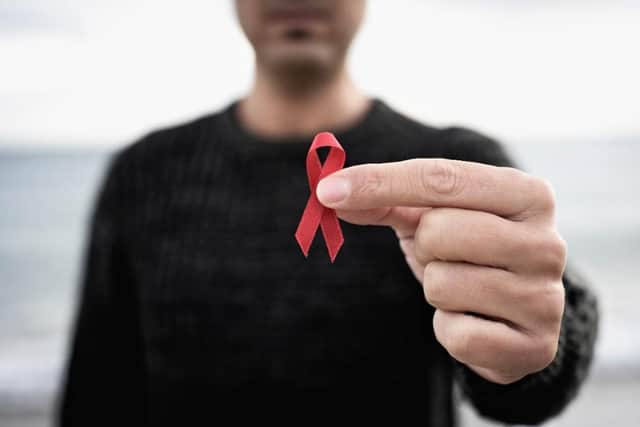World AIDS Day 2020: history of the day, this year's theme, and where to buy a red ribbon to show your support
World AIDS Day takes place on 1 December each year, and aims to raise awareness of the virus and the need to raise money, fight prejudice and improve education on the subject.
Over 103,800 people live with HIV in the UK, with an estimated 38 million people across the world who have the virus.
Advertisement
Hide AdAdvertisement
Hide AdHere’s why World AIDS Day is commemorated every year, this year’s theme and where you can purchase a red ribbon to show your support.


What is World AIDS Day?
The virus was first identified in 1984, but has since become one of the largest pandemics in history with 35 million people dying of HIV or AIDS.
Many scientific advances have been made in treatment and people are now much more aware of the condition, but the virus has not gone away and there is still work to be done.
Over 4,450 people are diagnosed with HIV in the UK each year and those living with the condition still face stigma and discrimination, despite the laws which have been put in place to protect people who have the virus.
World AIDS Day seeks to remind the public and governments across the world that the virus is still prevalent.
It encourages people to unite in the fight against the condition, while showing support for those living with it and commemorating those who have died from an HIV or AIDS-related illness.
When was World AIDS Day first commemorated?
World AIDS Day, founded in 1988, was the first ever international global health day.
It aimed to highlight the worldwide HIV epidemic, increase awareness and knowledge about the virus and end the stigma surrounding it.
Advertisement
Hide AdAdvertisement
Hide AdThe commemorative day and its events were implemented by journalist James Bunn, who worked at the World Health Organisation (WHO), and his colleague Thomas Netter.
At this point, the virus was highly stigmatised and people often blamed gay and bisexual men, and injecting drug users, for spreading it.
The theme of the first World AIDS Day focused on children, to steer away from these stereotypes and discrimination and raise awareness of how HIV and AIDS affects families.
As World AIDS Day grew, its organisation was taken over by the Joint United Nations Programme on HIV/AIDS (UNAIDS) from 1996 and it became a year-round education campaign rather than a single awareness day.
Now, on 1 December each year, United Nations agencies, global governments and the public join together for the campaign, with awareness and fundraising efforts taking place all over the world.
There is still a critical need for funds to support people living with HIV and AIDS, to raise awareness about what it’s like to live with the virus and to end the discrimination they face.
What is this year’s theme?
World AIDS Day focuses on a specific theme each year, which changes in line with the progress that has been made in tackling the virus and spreading awareness.
This year’s theme is “global solidarity, shared responsibility”.
Advertisement
Hide AdAdvertisement
Hide AdAccording to UNAIDS, the theme was decided as the coronavirus crisis has shown how health is linked with other issues, like inequality, human rights, social protection and economic growth.
It was also chosen based on the impact coronavirus has had on people living with HIV in populations around the world.
The UNAIDS website explains: “We have seen how the COVID-19 crisis has exacerbated the challenges faced by people living with HIV, women and girls and key populations, including in accessing life-saving health care, and how the crisis has widened the social and economic inequalities that increase the vulnerability of marginalized groups to HIV.”
The pandemic has also highlighted the importance of community engagement and solidarity when it comes to supporting people living with HIV.
Past themes have been “communities make the difference” in 2019, “know your status” in 2018, “my health, my right” in 2017 and “hands up for HIV prevention” in 2016.
Where can I buy a red ribbon to show support?
The red ribbon, the universal symbol of HIV worn to signify awareness and support, was designed in 1991 by a group of artists in New York.
At a time when HIV was highly stigmatised, the red ribbon was designed to be a visual expression of solidarity for those living with the virus.
Red ribbons and red ribbon brooches can be ordered through the National AIDS Trust online shop, or picked up from selected Morrisons supermarkets for a £1 donation.
Advertisement
Hide AdAdvertisement
Hide AdMorrisons will also be collecting donations at every till point across the UK on World AIDS Day.
The National AIDS Trust has also partnered with MAC Cosmetics, where you can add a red ribbon to your online order for a suggested donation.
The Trust will send out a pack of 100 red ribbons for free to anybody fundraising for the trust, and virtual fundraising materials are available, including a virtual ribbon, due to the coronavirus pandemic.